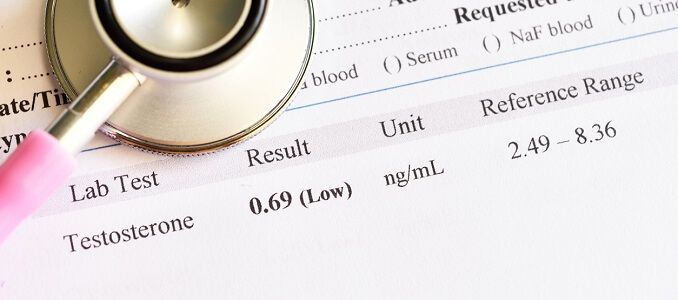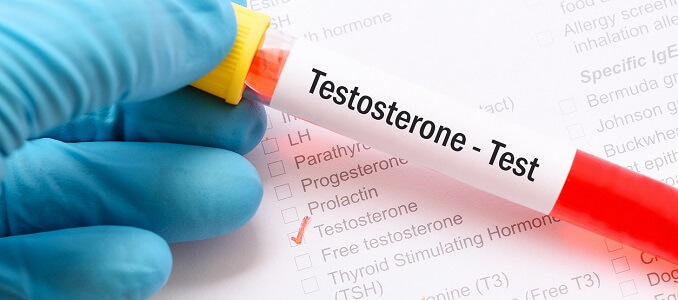Low Testosterone Levels in Men and Women
Your testosterone level is critical to the health and well-being of both men and women.
Most people know that testosterone is the most important male hormone. However, women’s bodies also make and need testosterone. Low testosterone is defined as a lower-than-normal level of testosterone. Testosterone levels decline as men and women age. Therefore the level of testosterone in your blood that is considered normal changes based on your age. Some conditions can cause low testosterone at any age, but most people between the ages of 40 and 65, need to worry about low testosterone. Low testosterone is often referred to as “Low-T.” In men, low testosterone may also be called “andropause.”
Men experience low testosterone symptoms over time as their testosterone levels slowly decline once they are over 30. Women experience low testosterone when they enter menopause, usually around the age of 50.
Causes of Low Testosterone Levels
There could be any number of conditions that can lead to low testosterone in men. Some diseases or injuries that can cause Low-T are:
- Type 2 diabetes
- Liver
- Obesity
- Pituitary gland problems
- Testicle injuries
- Tumors
Certain cancer treatments such as radiation therapy or chemotherapy can also reduce your body’s ability to produce testosterone. However, the most common cause of low testosterone is simply growing older.
Your testosterone levels naturally decrease as you age. Testosterone production ramps up during puberty. It continues to rise till you are around 20. In your 20s, your testosterone level remains at a pretty steady high. Once your reach the age of 30, your testosterone level starts a steady decline.
The most common cause of low testosterone is simply growing older.
At first, this drop in testosterone levels may be barely noticeable. But, most men between the ages of 45 and 65 will begin to experience the symptoms of low testosterone.
If the symptoms of low testosterone are becoming so severe that they are seriously impacting your quality of life, you may be a candidate for testosterone replacement therapy.
Low Testosterone Levels in Men
The normal testosterone level for a man changes over time. Also, depending on age, weight, overall fitness, and lifestyle, what is considered a normal testosterone level for one man, could be low for another. However, generally speaking, the normal range of testosterone levels for adult men is from about 270 to 1070 nanograms per deciliter (ng/dL). Anything below that would be considered low testosterone.
Since doctors know that testosterone levels can vary from patient to patient and yet could still be “normal,” we present “normal” testosterone levels for men as a range. The following charts indicate the normal testosterone levels for men at different stages of life.
Infants and children
|
Age |
Male (in ng/dl) |
|
0 to 5 months |
75-400 |
|
6-months to 9 years |
Less than 7-20 |
|
10 to 11 years |
Less than 7-130 |
Adolescents
|
Age |
Male (in ng/dl) |
|
12 to 13 years |
Less than 7-800 |
|
14 years |
Less than 7-1,200 |
|
15 to 16 years |
100-1,200 |
Adults
|
Age |
Male (in ng/dl) |
|
17 to 18 years |
300-1,200 |
|
19 years and older |
240-950 |
Symptoms of Low Testosterone Levels in Men
The symptoms of low testosterone in men impact four areas of health: physical well-being, emotional health, sexual wellness, and cognitive function. Some of the specific impacts of low testosterone in men include:
Low Testosterone and Bone Health
Testosterone, along with growth hormone, is critical for healthy bones. Men with low testosterone are at a greater risk of developing osteoporosis. If you have Low-T, you may also develop weak or brittle bones. This can make you more susceptible to fractures and broken bones if you fall.
Low Testosterone and Sex
Testosterone in men is intricately linked to libido or sex drive. Low testosterone can also be a cause of erectile dysfunction (ED), premature ejaculation, or other sexual health issues.
Testosterone, Mood, and Thinking
Studies have found that low testosterone can increase symptoms of depression and anxiety. Low-T has also been found to be related to cognitive issues such as memory and ability to focus.
Low Testosterone and Infertility
Testosterone is critical for sperm production. Men with low testosterone often have infertility issues due to low sperm count. The lower your sperm count, the less chance you have of fathering a child.
Low Testosterone Levels in Women
Testosterone levels are measured in nanograms per deciliter — ng/dl. The normal testosterone level for a woman is significantly lower than it is for a man. Women, on average, should have a total of 15 to 70 ng/dL of testosterone in their blood. Anything below that could be considered low testosterone and could result in the symptoms of female testosterone deficiency.
The following charts indicate the normal testosterone levels for men at different stages of life.
Infants and children
|
Age |
Female (in ng/dl) |
|
0 to 5 months |
20-80 |
|
6 months to 9 years |
Less than 7-20 |
|
10 to 11 years |
Less than 7-44 |
Adolescents
|
Age |
Female (in ng/dl) |
|
12 to 13 years |
Less than 7-75 |
|
14 years |
Less than 7-75 |
|
15 to 16 years |
Less than 7-75 |
Adults
|
Age |
Female (in ng/dl) |
|
17 to 18 years |
20-75 |
|
19 years and older |
8-60 |
Free and Total Testosterone
Most of the testosterone in your bloodstream is what is known as “bound” testosterone. Testosterone, like most hormones, travels throughout the body, bound or attached to other molecules, and is only released from that bondage when it reaches a target tissue. In the case of testosterone, it is usually bound to something known as sex hormone-binding globulin (SHBG). Some testosterone is also bound to albumin, and a smaller percentage exists in the bloodstream as “free” testosterone. As you might imagine, your total testosterone level is all of the testosterone in the blood at a given time. Your free testosterone level is the amount of unbound testosterone. “Bioavailable,” or active testosterone, is a measure of your level of free testosterone and the testosterone that is bound to albumin. When doctors are testing your testosterone levels to diagnose low testosterone, they are usually concerned with bioavailable testosterone even though they may test for total testosterone.
Generally speaking, about 60% of your testosterone will exist as SHBG bound testosterone, and about 35% is bound to albumin, and only about 2 – 5% exists as free testosterone.
If your doctor suspects you might have low testosterone levels, they will likely test you for your total testosterone level. Based upon the results of your total testosterone test, your doctor may follow up with a free testosterone test. However, a simple blood test for total testosterone is usually enough to provide a diagnosis of low testosterone levels.
The following chart illustrates the normal total testosterone levels for men and women by “Tanner Stage” and age. The Tanner Scale breaks down the observable signs of puberty into five stages, running from Stage I from about age 10 to Stage V at 15 for boys and about age 8 to 15 for girls.
|
Tanner Stage |
Male |
Female |
|
Testosterone (ng/dL) |
Testosterone (ng/dL) |
|
|
I |
<3 |
<3−6 |
|
II |
<3−432 |
<3−10 |
|
III |
65−778 |
<3−24 |
|
IV |
180−763 |
<3-27 |
|
V |
188−882 |
5−38 |
|
|
Adult Male |
Adult Female |
|
|
>18 y: 264-916 |
20 to 49 y: 8−48 |
|
|
|
>49 y: 3−41 |
Symptoms of Low Testosterone Levels in Women
Testosterone and testosterone replacement can be just as important for men as for women. In females, testosterone plays a critical role in maintaining healthy sexual desire, providing energy, strength, stamina as well as regulating mood.
The symptoms of a lower-than-normal testosterone level in women include:
- Lowered sex drive, vaginal dryness, and other sexual health issues
- Mood swings
- “Brain fog” or cognitive difficulties
- Fatigue and lack of energy
- Menstrual irregularities and/or increased menopausal symptoms
- Fertility issues
- Disturbed sleep
- Bone loss
- Inability to build lean muscle
- Thinning hair
- Thin, dry, or “creepy” skin
Diagnosis of Low Testosterone Levels
A diagnosis of low testosterone in men or women can only be made by having the testosterone levels in your blood tested. This is usually a simple blood test requiring few if any special instructions. A small vial of blood is drawn and will be sent to a lab for testing.
How Are Low Testosterone Levels Treated?
If your testosterone levels are low enough for a diagnosis of low testosterone, then the safest and most effective treatment is testosterone replacement therapy. Testosterone therapy is available in several forms. Our doctors have found that testosterone injections are the most reliable and most effective way to take testosterone.
By increasing your testosterone levels, testosterone injections can:
- Increase energy
- Improve mood
- Boost memory and cognition
- Improve your sex life
- Help you to lose weight and build lean muscle
- Reduce your risk of cardiovascular disease
- Reduce your risk of osteoporosis
FAQ
Do testosterone levels start dropping after 30?
Yes. In men, testosterone levels start a steady decline after the age of 30. A woman’s testosterone level drops more “all at once” when she reached the age of menopause – usually around 50.
Why do women need testosterone?
Women make and need testosterone for strength, energy, bone and skin health, and to maintain a healthy sex life.
What are the benefits of low testosterone treatment?
Low testosterone is treated with testosterone replacement therapy. The first few benefits that people on testosterone therapy experience is an improved sex life and an increased ability to focus on mental tasks. Beyond that, the many benefits of testosterone replacement therapy include:
- Improved heart health and a lowered risk of cardiovascular disease
- A lowered risk of osteoporosis by improving bone density and increased lean muscle
- Improve metabolism leading to weight loss and more energy
- Increased muscle strength
- Improved moods
- Improved sleep
What are the side effects of low testosterone treatment?
Testosterone therapy is generally regarded as safe. However, as with any prescription medication, there are some possible side-effects to testosterone therapy. Though rare, testosterone therapy side effect can include:
- Increased body hair
- Enlarged breasts
- Headache
- Increased anxiety
- Numbness (patches and gels)
- Pain or inflammation of the injection site (injections)
When is the best age to start testosterone treatment?
There is no specific age that is the best to start low testosterone treatment. Rather if you are a man or woman over the age of 40, the best time to start testosterone therapy is when low testosterone symptoms are interfering with your quality of life.
How low does my testosterone level need to be to need testosterone replacement?
While there are clinical guidelines that define low testosterone, it is hard to say how low your testosterone has to be to require treatment. This is because testosterone levels are very individual. What is normal for you could be fine for someone else. All men will lose testosterone as they age. Some men will barely notice. For others, the loss can be devastating. So, rather than speaking of normal levels, it is better to think in terms of symptoms. If you are exhibiting the signs of low-T, your levels are probably low enough to require testosterone replacement.
Now that you know a little bit more about testosterone levels and how they could impact your health and well-being, why not take a minute to contact us and learn more about how hormone replacement therapy can improve your quality of life?






